Please enjoy this Fun Guy Tale! Ok, enough of the shroomy puns, but I just couldn’t help myself.
“I suppose that what in other men is religion is in me love of nature.” ~ A quote from Henry David Thoreau’s journal, written on October 30, 1842.
There is something special about the forest in the springtime. When I close my eyes and picture myself deep within the woods, I take a deep breath in and I can actually smell her moist, earthy, dank richness, and it’s absolutely wonderful.
Perhaps it’s the excessively long winters of the upper Midwest, nothing to do and cooped up inside. Maybe it’s the birds singing their beautiful tunes, each unique song a part of the orchestra that springs life into the woods as the budding plants add their lovely green hues. The forest truly is a spiritual cathedral in the springtime, and it’s my happy place. My church.
Springtime is for Fungiphiles
Hunting wild edible plants and fungi brings me an unusually large sense of pleasure. I’m what you would call a fungiphile. I love mushrooms of every shape and variety. And mushrooms just so happen to love the growing conditions of forests.
Oh, mushrooms! So many wonderful varieties. So many interesting textures. So many delightful flavors. So many medicinal properties. It’s probably why I also enjoy psilocybin containing mushrooms. The effects. Not so much the flavors.
Disclaimer: Identifying and consuming wild mushrooms and other edible plants is a skill that should be approached with caution and shouldn’t be taken lightheartedly. Eating the wrong mushroom can result in death. Don’t mess around and only consume when you hunt with an experienced hunter or mushroom identification expert.
Aside from my lifelong mushroom hunting experience, I’m a certified wild edible and mushroom hunter and seller, which I obtained through the State of Minnesota Agricultural Department. Along with proper identification, another important aspect (and often overlooked) of mushroom hunting is access to hunting land. Get access beforehand or hunt and understand your local and state ordinances before hunting in state and national parks. Please don’t trespass. Some landowners are known to shoot uninvited strangers. Just saying. Springtime is also turkey hunting season. Wear bright clothing so you’re not mistaken by a trigger-happy hunter.
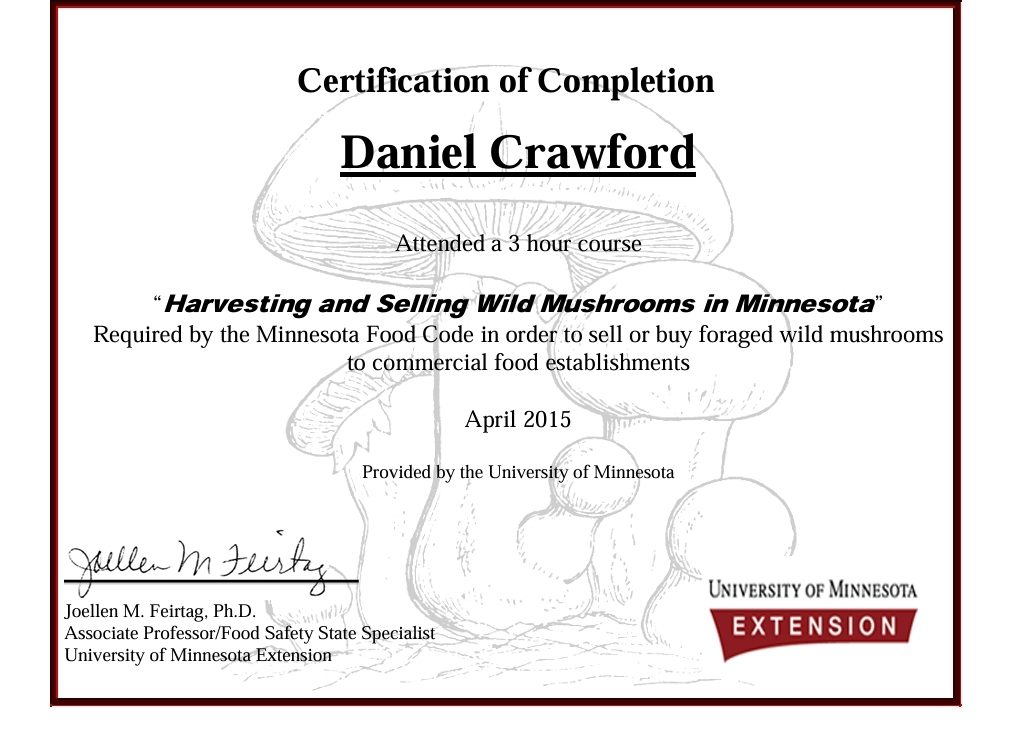
The Morchella Esculenta
One of my favorite mushrooms to consume is Morchella esculenta, or more commonly known as the morel mushroom. The tradition of morel mushroom hunting has been passed down in the Crawford family for generations, originating from the old hunting grounds somewhere near Danville, Illinois.
I’ve probably already said too much, but then again, no one ever took ME to the old hunting grounds…A word to the wise: Never share the location of your morel mushroom patch! Keep it secret, keep it safe because it is your Precious.
There are a lot of customs and traditions that surround morel and mushroom hunting in general. I feel it’s only right to honor those and to continue this treasured pastime for generations to come.
What are Moral Mushrooms?
In case you’ve never heard of a Morel mushroom, let me do some explaining.
Each Spring, for a short window of time, this peculiar fungus pokes out its little heads when conditions are just right. It can’t be too cold, but it also can’t be too warm. There must be a decent amount of moisture, but conditions can’t be too wet.
There are a few sayings that typically stand true: start hunting when the oak leaves are the size of a squirrel’s ear. Or when dandelions bloom away from sidewalks, like in lawns or pastures. And also when lilacs are in bloom. If these sayings are too difficult to extrapolate, try hunting around Mother’s Day. Combine these and a few other specific factors, and that’s morel mushroom hunting season in a nutshell!
Because morel mushrooms are so finicky, they have resisted cultivation in large scale. Because you can’t grow them in mass quantities, there is a limited supply based on natural environmental fluctuations and how many hunters are selling their excess hauls.
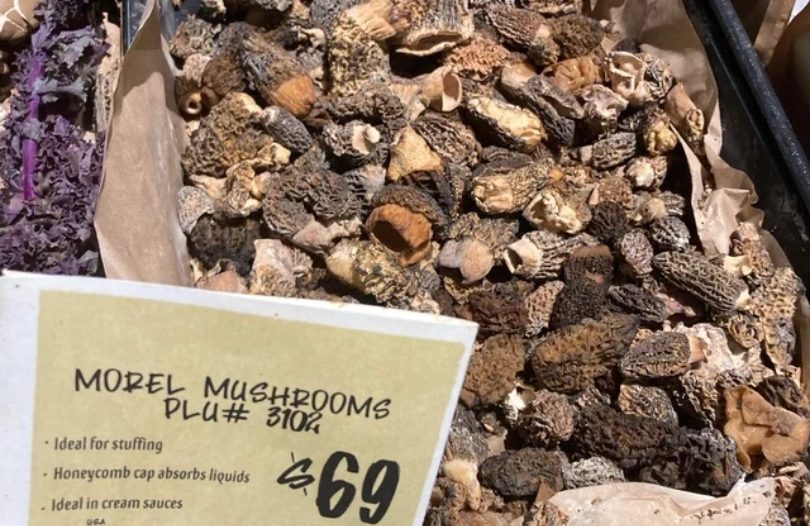
Each Spring, prices can range at the local farmer’s market or local food cooperative from $15 a pound all the way up to over $60 a pound. This is wet weight, mind you!
Even though the high costs, the mushroom is so deliciously wonderful that people will pay the price because the season is short and unpredictable. Who knows the next chance for a delectable bowl of crème de morel soup?
The Joys of Mushroom Hunting
Why do they say hunting as opposed to gathering? Well, morel mushrooms are hard to find. It takes skill and a ton of effort to find morel mushrooms in quantity. Trust me, the efforts are worth their weight in gold.
The morel is one of the weirdest mushrooms you’ll lay your eyes upon. It’s probably what drew me to it in the first place. Like a brain on a hollow stem. Ranging from the size of your pinky nail to over a foot tall, and spanning slightly different colors depending on the 3 main sub-species (black, golden, and grey) and can grow from Northern Florida to Southern California up into Canada. The mushrooms shift North as Spring carries winter away.
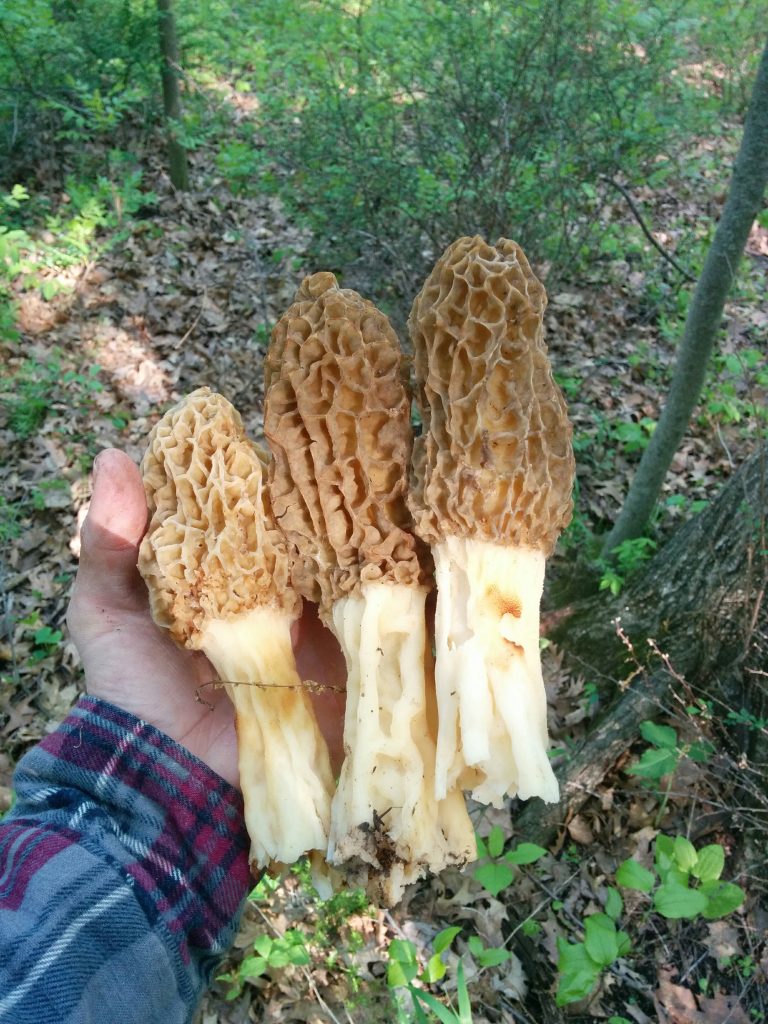
The morel mushroom is a culinary delicacy. They have a distinctive nutty and earthy flavor and are most often prepared in a “wild mushroom sauce” in combination with other gourmet shrooms served over a meat or in a cream soup. If you purchase Morels whole, it’s often sliced lengthwise, dredged in salted and peppered flour, and fried up in butter. Tasty little morsels!
Morels grow symbiotically with specific tree species. Knowing how to accurately identify tree species is key to unlocking the secrets of the Morel. It is the difference between walking around the woods collecting ticks and poison ivy and actually finding these sneaky little buggers.
Will the real Morel please stand up?
Don’t get too carried away. There are lookalikes and imposters lurking in the underbrush. False morels grow in similar conditions and at the same time of year as the morels. To the untrained eye, they have their similarities, but with a bit of investigation, truth emerges.
False Morels
False morels lack the hollow stem and head like the true morel mushroom. False morels have web-like filaments when split open. They also lack the distinctive nutty and earthy morel aroma.
Black Morels
Black Morel mushrooms grow in the northernmost regions and in the higher elevations, most commonly associated with pine forests. Said to be the least flavorful and the smallest of the 3 subspecies. Usually bountiful harvests follow recently burned and cleared pine forests.
Grey Morels
Grey Morel mushrooms are the standard bearer for the species in terms of size and flavor. Ranging typically from 2 inches up to 8 inches in size. These mushrooms are packed with flavor, and their smell is the essence of springtime in the forests.
Golden Morels
Golden morels are the largest of the 3 sub-species. Growing from 4 to 12+ inches in height, they are perfect for stuffing and frying crispy with a breadcrumb crust and a cheesy, herb-filled center.
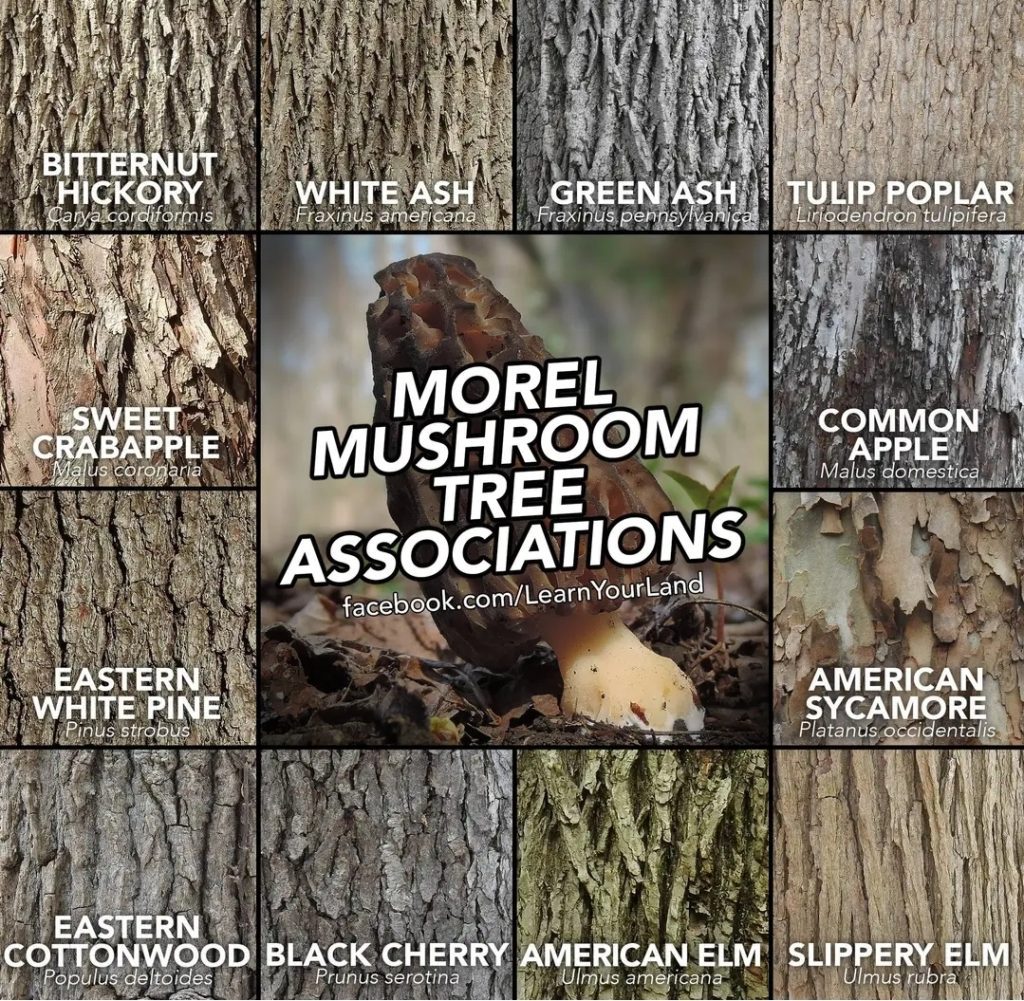
Side Walkabouts for Mushroom Hunters
There are many other springtime activities you can incorporate into your hunting trip while you find yourself wandering around the woods.
Edible fungi like Chicken-of-the-Woods, Maitaki, and oyster mushrooms linger nearby. Nests are filled with eggs of turkey and other songbirds, with shells of every color tempting a quick investigation. Baby fawns, too young to run, sit motionless, snuggled under the grassy brush.
Other wild edibles are plentiful and lie silently about. Patches of asparagus, wild ramps, and tender fiddle heads round out my harvest basket and bring the springtime foraged meal to life with flavor and color. Crisp, cool, clean water bubbles from the bluff-side spring-fed streams, providing the perfect habitat for fresh watercress and Salvelinus fontinalis, the native brook trout. Spring flowers are also in bloom.
From Rags to Riches – Finding the Mother-Load
I don’t know if I am unique in the fact that I can remember every single tree I’ve ever found a morel mushroom under. I have an internal GPS, a Google Earth in my brain where each location is secretly pinned.
Maybe it’s a skill that evolved from our days as hunters and gatherers, a forgotten skill set which helped early humans return to where their bounties were from season past. Either way, it’s my normal. Forgive me, for this is my sole superhero skill.
Don’t be discouraged when you start hunting if you have trouble finding anything at all. It takes years to hone your skills. Asking those who have experience and advanced morel mushroom skill sets is a pro move and will save you countless hours of fruitless hunting.
From the first time when my Grandpa led me, my cousins, and my siblings into the woods and down the trail, where we arrived at a downed Elm tree. There, lined up in a row, were 4 grey morels, 5 or 6 inches in height. My Grandpa showed us how to properly harvest by pinching just above the base to avoid disrupting the mycelium and leaving the forest soil and a morel stump behind. We inspected their bizarre texture and smelled their earthy goodness.
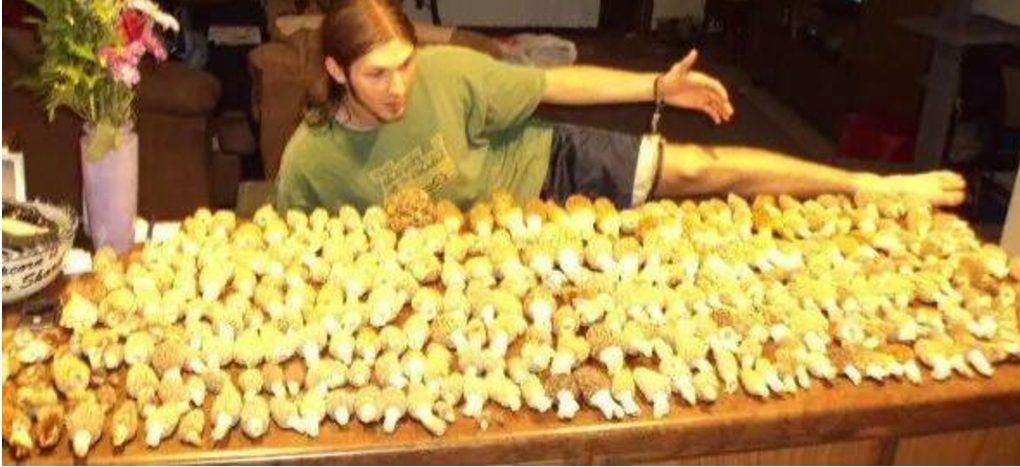
We took the morels back up to the kitchen and gave them a little wash and sliced them lengthwise in half. Dredged in flour and fried to a golden brown with butter and a pinch of salt.
I was no older than 6 or 7, but I can remember every single detail like it was yesterday. It was glorious. The following season, I was playing in the woods and happened upon the same Morel patch. Excitedly, I plucked the entire lot and ran joyfully back to my grandparents’ kitchen. To my Grandpa’s dismay, there were none left for him to pick, but he did get to eat a few.
Let that be a reminder and a lesson. Be careful who you share your morel patch with. They tend to grow in similar locations each season until the spot wanes and begins to peter out as the stored energy from the host tree dissipates. Once the location is out in the open, it’s fair game to whoever finds it first. There is nothing worse than trudging off to your spot only to find stumps in place of morels.
A Lifetime of Morel Hunting
Morel hunting would sink to the recesses of my mind, and it wasn’t until a serendipitous turn of events led this freaky fungi back into my life. I was a Junior in college working a landscaping job for the summer. I was in a customer’s backyard mowing around a giant tree stump when there they were. Glowing like a couple of golden brains, I plucked them and took them back home. It’s here where my addiction began.
Inspired, I went out and tried to have my hand, unsuccessfully, in a few morel hunts. The following season, after around 20 hours of hunting, I had found 2 morels by dumb luck. I had to change my hunting strategies, and that required a ton of research, planning, and scouting.
I took note of patches of Elm trees in the woods. I identified prime habitat that was also easily accessible and didn’t require hiking for miles. My success rates exploded the following season.
My Dad grew up in a morel hunting household. So when I told him I was taking my younger brother out hunting and he was skeptical and assumed we would come home empty-handed. (Don’t doubt me or I’ll prove you wrong, that includes myself!) We found about 50 around a single tree.
Now, most would be with a haul of that size. Heck, most never even come close to that in their lifetime. Not for me. I was hooked. Straight morel mushroom fever.
It’s hard to explain the feeling of finding giant patches of morels. It touches a place only other mushroom hunters can really relate to. Once you catch the bug, as hunting season approaches, you’ll be dreaming of finding a Mother-Load morel patch. As you drive down the road to work, you’ll find yourself gazing off into the woods, trying to locate the classic martini glass dead Elm tree silhouette, wondering if you have enough time to pull over and make a quick run into the forest.
Even with years of experience, as with any type of hunting, some years are better than others. Success can ebb and flow from season to season, and what success means can change as time churns by.
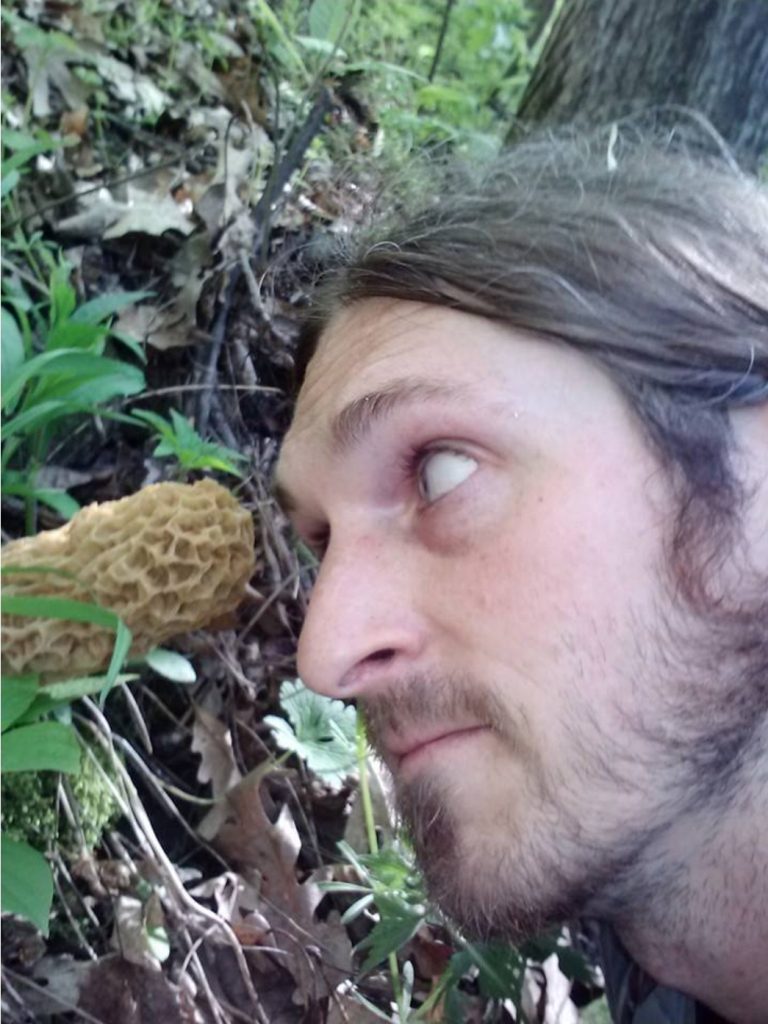
The Morel Harvest of a Lifetime
I had been scouting out some promising new hunting grounds earlier in the 2008 season. Everything looked right. So, when I felt the morels were popping, I headed to the remote valley with mesh bags on standby for any morels in my path. I crossed a small stream and a cow pasture until I reached the sweet spot deep within the woods.
I went straight for the first patch of Elms, and my eyes traced downward from the top of the tree, down the trunk with sloughing bark to the base where the tree met the earth. Scanning around my eyes saw every morel hunter’s worst nightmare. Clean-cut stumps. 4 or 5 of them. Someone had already hit this spot. I began to turn and make my way deeper into the valley when my foot tried to plant and slid instead. It was a morel. A bit smooshed, but still edible.
That’s when my eyes began to refocus. I rubbed my eyes because there were more morels than in my dreams. Everywhere my eyes went, I saw more and more morels peaking their heads out of the mossy grass on the hillside. I was standing in the middle of a giant morel patch. The Mother-Load!
From mushroom to mushroom, I plucked for hours. Hours and hours. I plucked for so long my fingers became wrinkled. I plucked until my 2 bags were overflowing and the sun was starting to set. I had to pull the plug and head home.
Alone in the forest, I danced the mushroom dance. I ground up a couple morels and sprinkled them into the breeze. A gift to leave behind, an appeasement to the mushroom and forest gods. I took a deep breath in and sighed, my Church.


